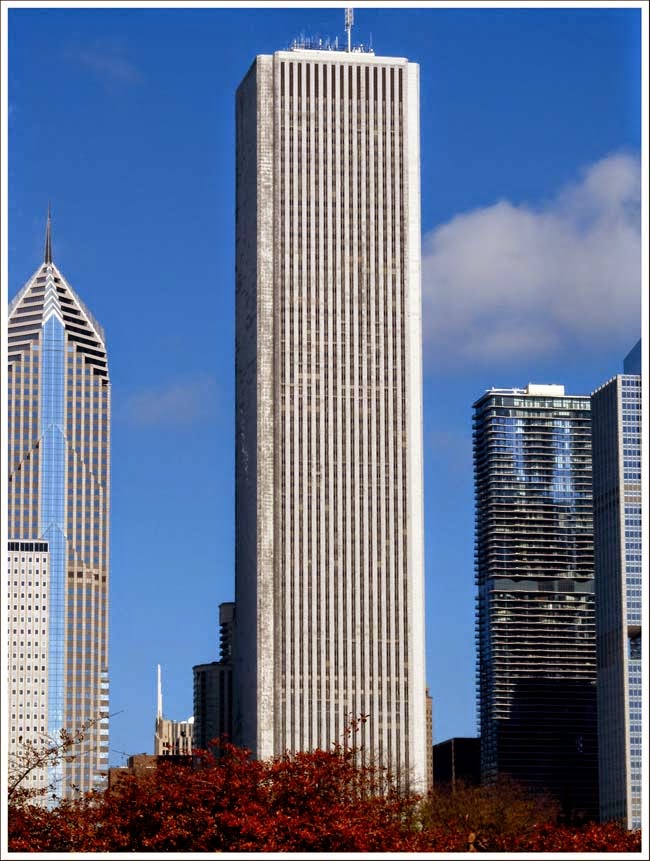Aon Center - Amoco Standard Oil Building
by: chicago designslinger
[Aon Center - Amoco Standard Oil Building (1974) Edward Durell Stone, architect; Perkins & Will associate architects /Image & Artwork: chicago designslinger]
When John D. Rockefeller died in 1937 he was the world's richest person - a title that he has been able to hold on to even though he's been dead for over 75 years. If you able were to gather together the estimated net worth of today's top 5 billionaires and put all that money into one account, that horde of cash still wouldn't reach Rockefeller's net worth at the time of his death - which would be around $365 billion in 2013 dollars. His fortune was based on oil - the gathering, refining, marketing and selling of the planet's liquid gold. But according to the federal government the oil tycoon's control of 90% of the domestic market was illegal, and in 1911 the billionaire was compelled to break-up his Standard Oil Trust into a series of subsidiaries, one of which, Standard Oil of Indiana, was based in the midwest and headquartered in Chicago.
[Aon Center - Amoco Standard Oil Building, 200 E. Randolph Street, Chicago /Image & Artwork: chicago designslinger]
Standard Oil had maintained offices in Chicago since the 1880s and in 1927 consolidated their scattered workspaces into one location on south Michigan Avenue. Forty-years later when company chairman John Swearingen decided that it was time to move, Standard of Indiana had grown into one of the world's largest oil-producing corporations and the old building didn't prominently proclaim the company's dominant presence in the global marketplace. He picked a potentially eye-catching site on the north edge of Grant Park at Randolph Street close to the 41-story Prudential Building and a little west of the 40-story Outer Drive East apartment building. Standard purchased land that sat several feet below the elevated deck of Randolph which bridged a sliver of acreage that belonged to the Illinois Central Railroad. The property had once been the home of the massive railyard of the Illinois Central Railroad, and while the rail line had begun making plans for a monumental redo of their lake front acreage in the late 1920s, the Great Depression and the Second World War stymied their efforts. So the plan didn't really start to take shape until the Prudential Insurance Company built their project in the early 1950s. After securing the site, Swearingen selected over two dozen architectural firms to submit ideas, narrowed the field, had the remaining firms refine their proposals, and the winner ended up being New York-based architect Edward Durell Stone with Chicago-based Perkins & Will as the local architects of record. Stone would be responsible for the overall design of the building while Perkins & Will would take on the job of translating the concept into the actual working drawings and oversee construction.
[Aon Center - Amoco Standard Oil Building, Illinois Center, Chicago /Image & Artwork: chicago designslinger]
Swearingen was a Chicago powerhouse. Standard of Indiana employed over 8,000 people in the region, and it was during the native South Carolinian's tenure that the company went from what he considered a "second rate" oil company, into one of the world's largest corporations. Architect Edward Durell Stone got noticed after designing the new home of New York's Museum of Modern Art with Phillip Goodwin in 1939. He gained international recognition in 1954 for his U.S. Embassy building in New Dehli, and designed the General Motors Building and the controversial museum building for Huntington Hartford in New York City in 1964. The facade of the new, 83-story, Standard Oil skyscraper resembled Stone's General Motors project but the internal structure of the equal-sided square tower in Chicago was supported by the exterior wall frame and an inner central core which provided for column-free floor plates, much like the design architect Minoru Yamasaki's would utilize for his World Trade Center buildings in lower Manhattan.
[Aon Center - Amoco Standard Oil Building, Chicago /Image & Artwork: chicago designslinger]
When the building was completed in 1974 it was the tallest building in the city, and was a very publicly projecting testament to John Swearingen's tenure. Stone's structural-plan-providing narrow vertical bands of windows framed by equally narrow vertical bands clad in white Cararra marble made the already towering skyscraper appear even taller. Unfortunately the choice of the Italian-quarried-stone proved to be a bad one. Given Chicago's unforgiving climate the marble slabs didn't hold up well when faced with the city's weather extremes. In 1992 Standard Oil of Indiana, now known as Amoco, undertook a massive desconstruction/reconstruction of their four 1,136-foot tall facades and replaced the marble with a more climate resistent granite. John Swearingen had retired by then, and in 1998 British Petroleum began retiring the Amoco brand after purchasing the American-based conglomerate. BP began moving personnel out to the suburbs soon thereafter, and in 1999 the Aon insurance company moved into the vacated space. They took on the name of the tower for themselves, then in 2012 Aon moved their corporate headquarters to London. Ironically, ten years after BP began moving personnel to the burbs, the company moved back into the city since their increasingly younger workforce had chosen the city over the suburbs. However, BP did not choose to re-relocate back into the Stone/Swearingen tower.




No comments:
Post a Comment
Note: Only a member of this blog may post a comment.